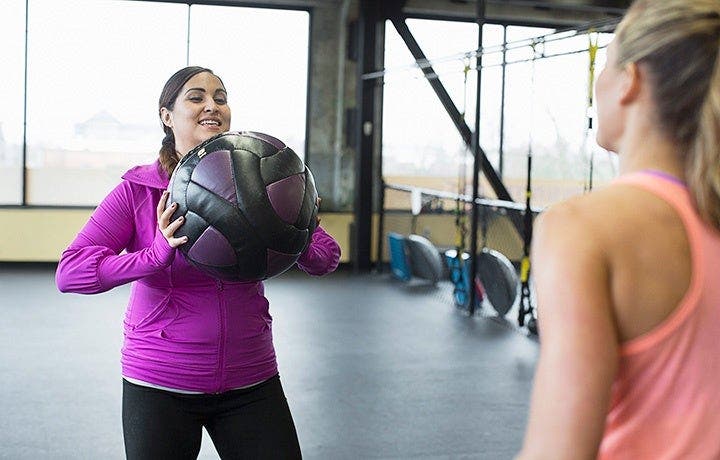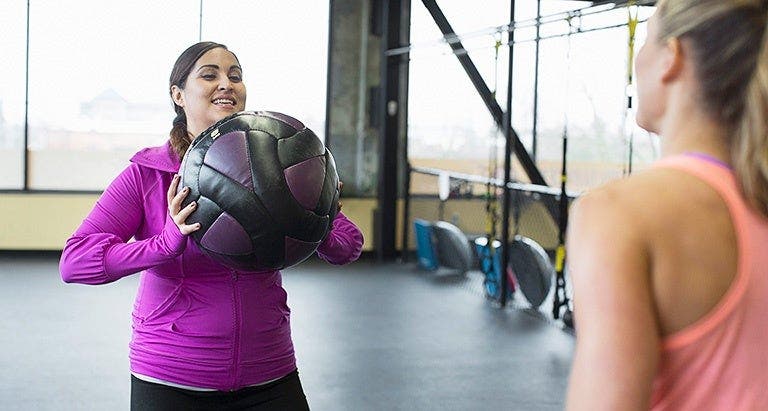How to lose body fat and build muscle


Getting started is the toughest part of any exercise program.
Perhaps going to the gym or even staying home and following a workout DVD isn’t your thing. But trust us, if you can manage to break the inertia and get consistent with even the most basic resistance training program—2-3 days per week, low impact, minimal time investment— the benefits you’ll reap will be well worth the sweat equity.
To get an idea of how your body will change physically in the first 3-6 months of doing strength building exercises regularly, we asked two noted exercise scientists to boil it down from a physiological standpoint—yet keep it simple enough that all of us non-PhDs could understand.
Knowing what’s going on in the body when you lift weights, and what results you can expect to get from it, might just nudge you towards a brand new way to move your body.
How strength training promotes fat loss
Weight loss may be your primary objective, but more specifically, you should be aiming for loss of body fat, not muscle; this is partly what people mean when they say “healthy weight loss.” And for fat loss, even long duration cardio won’t beat resistance training.
“There are two primary ways that resistance training helps promote fat loss,” says N. Travis Triplett, PhD, a Professor of Exercise Science at Appalachian State University in Boone, NC, and the President of the National Strength and Conditioning Association (NSCA). “The first is that resistance training workouts burn more calories after the workout than your typical cardio—lower intensity, longer duration—workout. This has been demonstrated in several studies and is a result of the body trying to restore itself to pre-exercise levels, which takes more effort from resistance exercise since it breaks down muscle proteins more.
“Second, compared to fat, muscle burns far more calories in general, so having a higher proportion of muscle on the body—a known result of resistance training and not cardio training—helps keep resting metabolism higher, which also helps with fat or weight loss.”
What happens to your muscles when you start exercising
Improvements in body composition (your ratio of muscle to body fat percentage) can be evident in the first month or two of a resistance training program, especially if you’re new to doing strength training exercises, and eating well.
This is the result of both building new muscle—also known as hypertrophy, and losing body fat. And fortunately for newbies, there’s some “beginner’s luck” involved.
Those who haven’t been exercising will experience greater muscle responses when they start strength training compared to someone who lifts weights regularly. “This is because experienced lifters are closer to their ‘genetic ceiling,’ and the gains are smaller,” says Triplett. “That said, hypertrophy is not usually obvious for at least 4-6 weeks of training, and often not until after about 8 weeks of training. What’s happening at the same time, though, is a loss of some of the fat right under the skin, so the muscles start to become more defined.”
Muscle vs. fat
What you may not see right away is this: your bathroom scale showing the pounds rapidly dropping off. Don’t be alarmed, says Jaci VanHeest, PhD, Associate Professor in the Department of Kinesiology and Educational Psychology at the University of Connecticut in Storrs.
“Often, individuals are disappointed because they gain some weight or remain weight stable when they start resistance training,” says VanHeest. “You’ll begin to see increases in muscle mass with resistance training, and these increases will result in changes in how the body looks. You may see changes in how your clothes fit and how your arms and legs look in the mirror. Individuals will tend to see these changes before they notice weight loss on the scale. Use a mirror to motivate.”
Triplett echoes these sentiments. “Someone could be gaining weight and think it’s bad because they don’t realise they’re losing fat and gaining muscle,” she says. This can be discouraging, but there are a lot of positive changes going on under the surface. The muscle is slowly growing and fat is slowly decreasing.”
Why strength training is a health hero
The important thing to remember is that resistance training offers a myriad of benefits for not only your weight loss goals, but also your overall health and wellbeing, whether you notice these changes right off the bat or not.
“When a sedentary person begins a resistance training program,” says VanHeest, “he or she can begin to show a reduction in resting blood pressure and a decrease in exercise heart rate, in addition to improved body composition and increased muscular strength and endurance.”
Triplett stresses the importance of staying the course and looking past the short-term: “Over a longer time—more than 6 months, the average person training with various forms of exercise and eating sensibly with regard to caloric intake and nutrient balance is likely to see anywhere from a 3%-5% or greater loss in body fat.”
RELATED: How to fit exercise into your life
